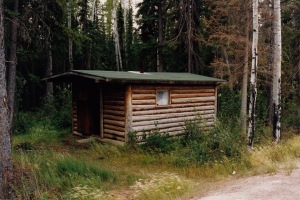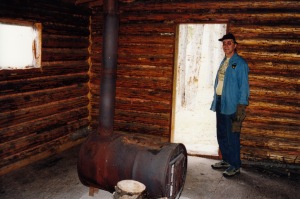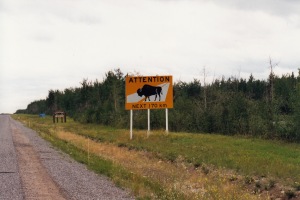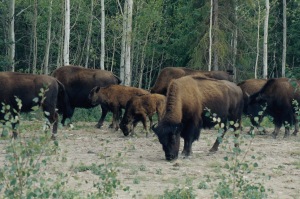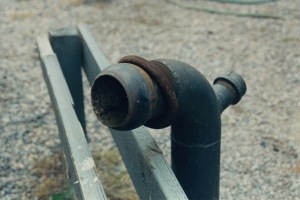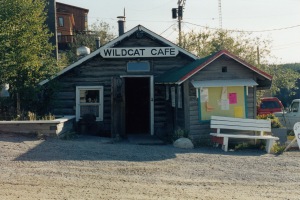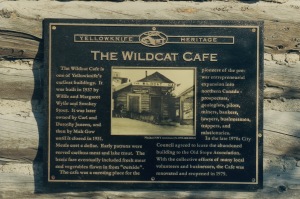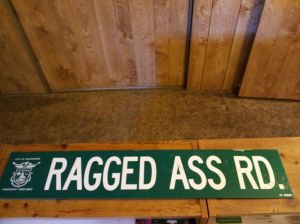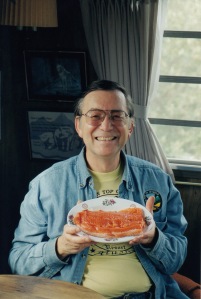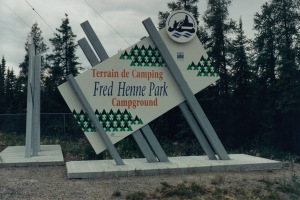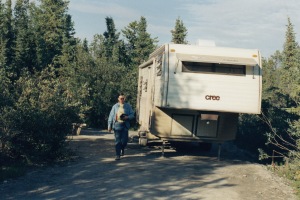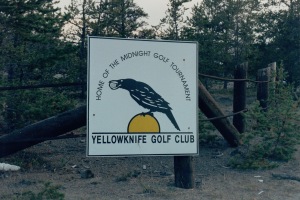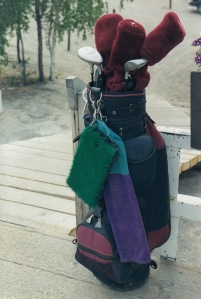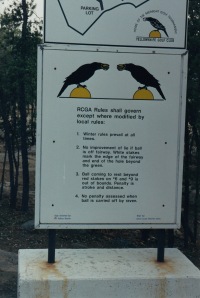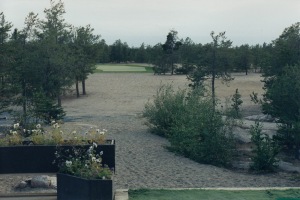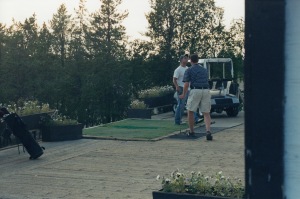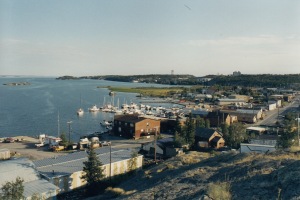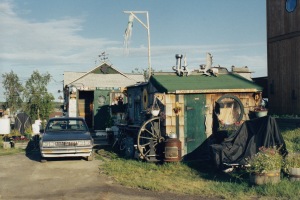We left the Sambaa Deh Falls campground and continued eastward across the Mackenzie Highway, to where we would make a turn due north on the last leg of our trek to Yellowknife. We only had 56 more miles of gravel then we would get back onto paved roads – finally. We were so paranoid about breaking another spring (we had used up our very last one) that we drove only 35 mph. Our plan was to buy another spare spring – maybe 2 – when we got to Yellowknife.
We came to a small clearing along this gravel stretch of road. There was a tiny cabin there so we stopped to walk the dog and check the springs for the forty-eleventh time and look over the cute little cabin.
Inside, we saw a sign stating that this was an emergency shelter in case you broke down in the winter going across on your snowmobile, dog sled, or whatever. Anyone was welcome to use it until they could get help somehow. It was stocked with firewood out back and had a wood stove inside.
Isn’t it cute? It was not uncommon to find these along the lesser-traveled roads in the far north. They were lifesavers for people who used them. You would be on your own for building a fire, eg, matches, or whatever you would use. All travelers in the far north carry emergency kits with those kinds of things in them whenever the go anywhere. You could be stuck somewhere for days depending on which road you were on if you broke down and what the weather was like.
We finally made it to where we turned north onto Highway 3 which ended at a native village called Rae. From there we turned due east onto Highway 4 which went to Yellowknife. Sadly, this last stretch of road to Yellowknife was gravel. Sigh.
Along Highway 3, we passed through a large Wood Buffalo preserve. Wood Buffalo are quite different from the buffalo found in the northern United States. They are MUCH larger and woolier and are a dark brown color.
This sign alerted us to watch for the buffalo. When we finally came to some grazing along the sides of the road, we were absolutely awestruck. To say they were huge is an understatement.
I am not kidding you or exaggerating when I tell you that this animal was the size of our Ford F-350 crew cab truck! It was scary huge. We saw several of these tremendous creatures along the road sides – including some females with calves. The calves were the size of fully-grown Texas steers! Even the females were almost as big as our truck. These were a thrilling sight to see. We also saw some sandhill cranes but they were not in good places to get any photos. We saw moose, too.
We passed through the native villages of Edzo and Rae and began making our way across the final stretch of the gravel road to Yellowknife. Yellowknife is the capital of the Northwest territories and at the time we were there, it had a population of about 19,000. The city is build on and around massive chunks of pre-Cambrian rock – the oldest exposed rock on our planet. There are only a few places on our globe that have large areas of this exposed, ancient rock. There were lots of large, pink quartz-like intrusions of rock folded into the darker basalt. They looked like meandering trails. We had never seen anything like this type of geology in all of our travels.
The houses and buildings in Yellowknife are some very strange shapes and sizes because of having to be fitted into the basalt terrain. It would be pointless to try to move or alter any of this massive rock, so people just build on and around it. There is very little flat, level ground around town and what there is, was used up for government and office buildings in the downtown area and out at the airport. There were many house trailers. We looked around at housing prices and found that a trailer in a trailer park sold for $100,000 and up, and a stick-built house started at $250,000 for a very small one. Remember that this was back in 1999 when the only place you saw housing prices like that was in California!
They had a novel sewer and water system. All the properties had a large sewer connection pipe out at the street with a dump valve just outside their house or business.
Periodically, a large sewer truck would come by and hook up to the this pipe and activate your sewer dump valve and your sewage would empty into the truck. He’d close everything back down and drive to the next property’s valve. When his truck was full, he’d take it to the sewage treatment plant and empty his truck. Then he’d go back and continue on his route. He’d come by a couple times a week to dump your sewage.
It was a similar sort of set up for water service. People had a water pipe out by the street and a fresh water truck would come by a couple times per week and fill up the cistern in your residence or business. Since the ground is all solid rock, all the utilities have to be aboveground. It was a similar kind of system over in Inuvik – only over there, the problem was mostly because of the permafrost as well as some rock. There are no basements anywhere in town as this pre-Cambrian shield basalt allows for no digging. Yellowknife sits right on the northern shore of the Great Slave Lake which is the deepest lake on the North American continent at over 2000 feet deep – even deeper that Lake Superior. The water is crystal clear and icy cold.
We had lunch at the famous Wildcat Cafe, a tiny restored original building/cabin. We feasted on Carrot Ginger Soup, Arctic Char Chowder, and Musk Ox sandwiches.
The Wildcat Cafe is one of the original buildings from the early Yellowknife settlement. They served regular bistro food plus some local favorites such as the musk ox and the Arctic Char.
The Wildcat Cafe was along Ragged Ass Road, which was truly the name of the road. We bought one of their roadsigns at the Highway department. They said they took to making them and selling them to tourists to keep them from being stolen all the time. There were signs on the signposts telling people they could buy one of the signs at the Highway office to try to keep down the theft.
A word about the fish of the far-north waters called Arctic Char. It is like a cross between trout and Alaska salmon. We found a meat market in town that carried fresh Arctic Char and bought a fresh fillet of it. We took it back to our campsite and grilled it on our small charcoal grill. It was fantastic!
The campground we stayed in just outside of Yellowknife actually had a small laundry facility. We were very happy to find this available. The campground was beautiful – set amongst the massive basalt of the Pre-Cambrian shield.
We had a lovely site, although it wasn’t completely level.
We made do with it and Paul got us in pretty good shape with some of our leveling blocks placed under the low side.
While at the laundry building, we met a young man, who with his girlfriend on back, had ridden a motorcycle all the way up to Yellowknife from Miami, Florida. That is 3940 miles!! One way!! He had just put his girlfriend on a plane to fly back to Miami. She wasn’t up to doing the return trip. They had been camping the whole way. I can’t even imagine! I’d love to know if that was the end of that relationship, or just a beginning?
The next day we went over to explore the Yellowknife Golf and Country Club.
Too bad we didn’t have our clubs with us! This was the golf course from hell, however. The fairways are all sand and gravel, but they have real greens – of a sort. Everyone carries a foot-square piece of Astroturf clipped to their bag to put under their ball to hit it.
Winter rules are in effect all year long and there is no penalty if a Raven picks up your ball and carries it off. This happens all the time. For some reason, Ravens like golf balls and they steal them whenever they get the chance.
Here is a photo of the club rules.
Here is a shot of one of the fairways.
See? I told you. It’s really sand and gravel Below is a photo of the first tee box. It is made of artificial turf.
This club was hopping, let me tell you. I don’t think we could have gotten on the course even if we had our clubs with us. People were teeing off continuously the whole time we were visiting there. This club claimed to be the farthest north golf club in the world. We couldn’t argue with them.
We spent time touring around just looking at the city. The surrounding lake and inlets are gorgeous. There were many pricey sailboats and yachts in their marina and out on the lake. Some fishing boats, as well.
Below is a photo of something we found very curious. It is of a 2-story houseboat – one of many we saw tooling around out on the lake. The fact that we saw 2-story houseboats wasn’t unusual. The fact that was unusual, was that people were cruising around in them all over the lake! We never before saw people cruising around lakes or rivers in their houses!
Here you can see that the view of downtown Yellowknife shows tall office towers like you would see in any large city anywhere else. The strange thing is that they are just sitting on all this basalt, anchored by enormous pilings drilled into the solid rock.
When we got back to our camp, we filled in another Province sticker on our “Where We’ve Traveled in Our RV” map on the inside of our RV door.
We spent some time in a few art galleries and gift shops downtown looking at the native northwestern-themed art. The paintings, carvings, and clothing were so unique and beautiful. The artists were very talented and expressed their everyday lives in their work so well. The town of Yellowknife got its name from the color of the knives that the natives made out of copper. People think it came from the gold in the area, but it really came from the use of the native copper in their knives.
Here is a photo of a noted gift shop we visited called Three Bears Gift Shop. It actually had a lot of native art for sale and many far-north souvenirs, as well as some of the local diamond jewelry. Diamond jewelry? In this shop? Who knew?
At the time we were in Yellowknife (1999), there were two large active gold mines in the area. These were the town’s major job sources. Geologists had just discovered lots of diamonds in several kimberlite pipes north of the town which was generating a lot of buzz. The prosperity and commerce in the area was poised to take off for the moon. Geologists from all over the world were all over the area looking for diamonds in the oldest exposed rock on earth. The only other area where these features exist is in Australia.
As was predicted at the time we were there in 1999, over the next few years the area did indeed erupt in new diamond mines north of Yellowknife, which are the source of many of today’s gem-quality and industrial-quality diamonds. These diamonds are extra valuable as they are “non-conflict” diamonds, meaning their sale does not contribute to unethical dictators and regimes who abuse workers and human rights.
As a side note, Paul spent some time looking for a replacement spring at several truck and RV repair places and auto parts shops all over Yellowknife. No luck at all. They said if we really needed a spring, they could have one sent up by air from Edmonton but that it would cost about $500 to do that. We decided to risk it and limp back towards Edmonton hoping the ones we had were going to hold up. We were headed that way next anyway.
You’ll need to read the next post to see if we made it

